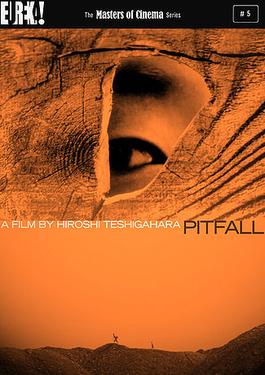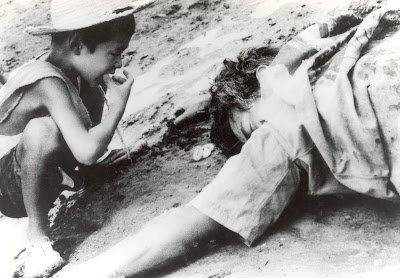
In the work of Teshigahara, the influence of literature was present regardless of Kobo Abe’s presence in collaboration because the melting pot that was his films held no constriction to genres or customs in order to get an idea across. The famous words, documentary-fantasy, are really not all that paradoxyl, for what else is art but a bunch of truth-telling lies? Aside from that, in an interview he stated he wanted to do a film about the coal industry at the time, and so he used this urge as a conduit for his social and political views, as well as experience since Pitfall would be his first feature film (as he had only done documentaries previously).
The film has many elements that pop out sporadically to have their say, but cumulatively they aren’t necessarily related to each other. You have the ghost story, the man in white, the boy’s perception of it all, political battle over union leaders, policeman raping the shopkeeper, and so on. It’s a bit of a miracle it’s all able to tie in on the surface, but overall the film is more thematic than pragmatic. The most apparent thing is how much each character watches the others: The man in white taking pictures, the shopkeeper watching the murder, the ghosts doomed to watching, and the boy, who’s perspective we follow the bulk of the time. In conjunction with the 4 murders, the “woe-is-me” ghosts, and those who ignore it all, the idea of simply watching is a very literal statement against…well, everyone. You always hear something terrible on the news, see some parent beating their kid in their car, but alas, not your place, eh? The man in white who kills our protagonist even directly asks the shopkeeper, and us in turn as his head was decapitated by the door frame, “you were watching that, weren’t you?”

Speaking of the man in white…though this is a black and white film, even if it was in color it would still be black and white. Everyone wears white clothes, the coal mountains are black, the dirt on the workers is black, and between dialogue the film cuts away from the characters in white to the indifference of a natural hill or skyline, as if to say white cannot be correlated with purity anymore. The film is saying it’s an illusion to feel safe in society where you are not even heard when you speak, which is what the ghosts represent, and this is where the film provides a critique of working class subjugation at the expense of their personal fulfillment (“"Being invisible might have been useful when I was alive, but this is unbearable"). Maybe this is why the film links scenes together with clips of animals. It’s actually rather Buñuelian, but unlike Luis, Teshigahara uses the motif as a comparison rather than a conglomeration. Why else would all the murders take place at the bottom of this mammoth hill from a camera angle that makes the people look like mere ants?

Because of this, the theme of industry is prevalent in a Japan rebuilding after the war (perhaps preparing for their Olympics debut?) and in turn their people are run like numbers, they have no more identity. When the man in white addresses shopkeeper to be quiet about the murder she witnessed, she agrees for money and lies to the police, only to have a policeman rape her, only to have the man in white come back to kill her and take his money back. I don’t even need to say what that represents.
With all this in mind, why would Teshigahara keep most of the film in the child’s perspective? The child is that of the miner who was killed by the man in white, but the child didn’t cry when inspecting his father’s corpse, he just stole his candy. Earlier in the film, he denied candy from a nice woman, but when he gets to the shopkeeper he tries to steal it, then he steals from his dead father, and then he steals more at the end of the film before running into town where all the miners are working (candy + influence = duh). This also ties in with the man in white’s departure from the film. After he killed the miner, the shopkeeper, and lured the two union leaders, one of which was the lookalike and the other the scapegoat for the miner’s death, to the same location where they killed each other, he simply goes to his motorbike and, amongst the wailings of the ghosts “why are you doing this?”, he cleanly speaks, “Exactly as planned.” He’s got a nice suit, fancy watch, and a motorbike, tying him to the inflation of industry in Japan, further tying this rise run by men in suits to dog fighters. What a ****ing sad ending. I guess you don’t have to be caustic to be accurate.

Last edited by wintertriangles; 01-30-11 at 03:57 PM.

